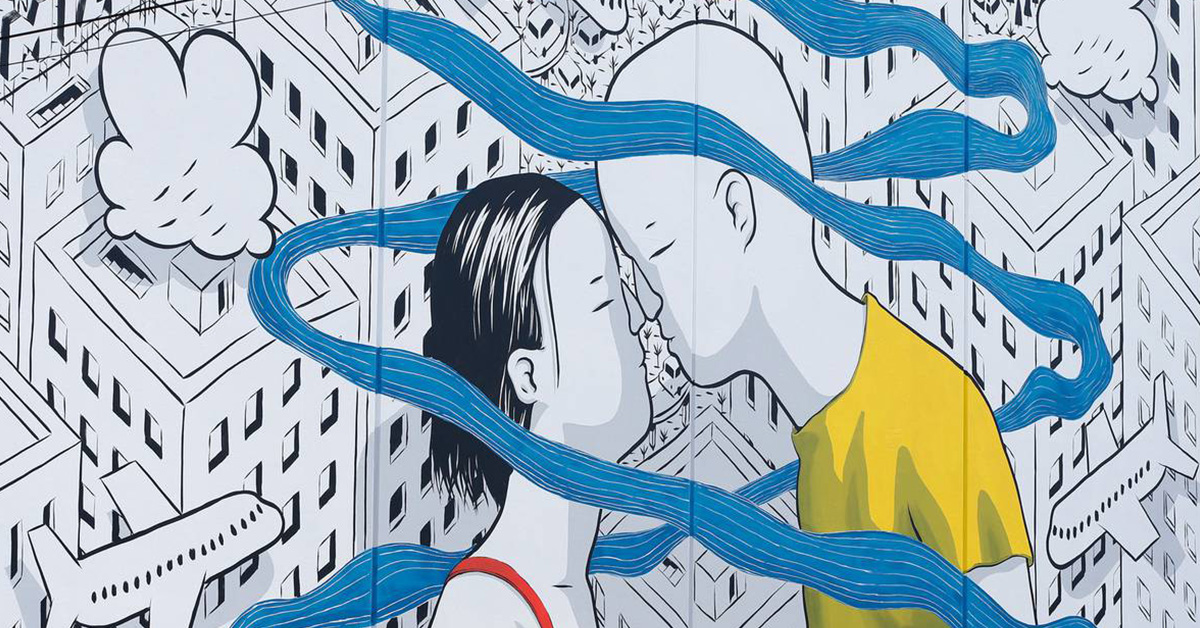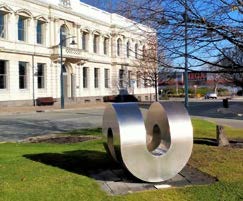
Four Corners
Publicly Artful
Our country is dotted with significant public art. Some works are heavy and monumental, others carefully detailed, and at least one digitally dynamic, but all are framed by their built and natural surroundings.
WHANGĀREI
Connection
Italian artist Francesco Camillo Giorgino, known as Millo, has depicted a hongi in this large-scale illustrative mural. Black and white lines define the scene of two people greeting each other, woven together by a blue breath. Painted on the back of the police station on Lower Cameron St, it’s part of Whangārei’s street art trail, 15 murals based on the theme “Tuia te muka Tāngata — weaving the threads of humanity”.

Russell Beck’s Syncline. Photo: Christopher Greenfield.
TIMARU
Shining Winner
Using 250 kilograms of stainless steel, Russell Beck concisely reimagined the undulating hills and valleys of Timaru in Syncline. The minimalist shape is never-ending, the flat surfaces curving into themselves. This shiny, rolling form won the Heartland Sculpture Challenge in 2009, thus securing it a permanent location opposite the council chambers on King George Place.
ROTORUA
Rising Red
Among the greenery of Kuirau Park, seven bright-red steel beams stack and spiral upwards. Stamen, by local artist Trevor Nathan (Ngāti Maniapoto, Ngāpuhi), is simple and surprising. Its modern forms and glossy bold surfaces are reminiscent of the pōhutukawa flower.
PALMERSTON NORTH
Roundabout Ripple
Returning Column upends expectations of structure as it wavers five metres high and curves back down to its base on the roundabout at the junction of Main St and The Square. The corten steel sculpture was made by South Australian artist Greg Johns, its form resembling electromagnetic wave patterns and the shimmer of hot arid landscapes.
WELLINGTON
Screening Now
Masons Screen is a single monitor tucked away down Masons Lane, a pedestrian walkway connecting The Terrace to Lambton Quay. It runs 24 hours, seven days a week, screening videos of the work of contemporary NZ artists. The programme changes monthly and has featured Judy Darragh, Ana Iti, Christopher Ulutupu and Sriwhana Spong.
HAVELOCK NORTH
A Guarded Spring
The cylindrical veil of water and the location of sculptural fountain Te Haaro o te Kaahu point to the nearby spring around which Havelock North village was built. The waters of the fountain are watched over by a silver geometric kāhu (hawk), a figure in local lore. The artist, Paratene Matchitt (Te Whānau-ā-Apanui, Te Whakatōhea, Ngāti Porou), was a leading figure in contemporary art from the 1960s, known for combining Māori art with modernism.
DUNEDIN
A Passage to Mana Whenua
Ayesha Green (Kāi Tahu, Ngāti Kahungunu) created Ko te Tuhono, which references her whakapapa. Standing tall in the lower Octagon, it’s a cast-aluminium replica of the doorway into Ōtākou’s wharenui Tamatea. Deep red, it duplicates the intricate details of carvings. The work acts as a passage to a landscape with ancestral ecologies, and presents a different worldview to the surrounding architecture.

Ko te Tuhono (detail) by Ayesha Green. Photo: Nico Penny.
Gabi Lardies is a The Next Page intern, a role funded by NZ On Air’s Public Interest Journalism.

This story appeared in the August 2022 issue of North & South.
